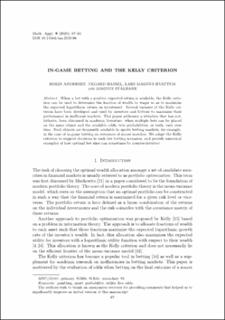In-game betting and the Kelly criterion
| dc.contributor.author | Andersen, Robin | |
| dc.contributor.author | Hassel, Vegard | |
| dc.contributor.author | Hvattum, Lars Magnus | |
| dc.contributor.author | Stålhane, Magnus | |
| dc.date.accessioned | 2023-10-11T05:52:05Z | |
| dc.date.available | 2023-10-11T05:52:05Z | |
| dc.date.created | 2021-01-05T12:09:11Z | |
| dc.date.issued | 2020 | |
| dc.identifier.citation | Mathematics for applications. 2020, 9 (2), 67-81. | en_US |
| dc.identifier.issn | 1805-3610 | |
| dc.identifier.uri | https://hdl.handle.net/11250/3095646 | |
| dc.description.abstract | When a bet with a positive expected return is available, the Kelly criterion can be used to determine the fraction of wealth to wager so as to maximize the expected logarithmic return on investment. Several variants of the Kelly criterion have been developed and used by investors and bettors to maximize their performance in inefficient markets. This paper addresses a situation that has not, hitherto, been discussed in academic literature: when multiple bets can be placed on the same object and the available odds, true probabilities, or both, vary over time. Such objects are frequently available in sports betting markets, for example, in the case of in-game betting on outcomes of soccer matches. We adapt the Kelly criterion to support decisions in such live betting scenarios, and provide numerical examples of how optimal bet sizes can sometimes be counter-intuitive. | en_US |
| dc.language.iso | eng | en_US |
| dc.relation.uri | http://ma.fme.vutbr.cz/9_2.html | |
| dc.title | In-game betting and the Kelly criterion | en_US |
| dc.type | Peer reviewed | en_US |
| dc.type | Journal article | en_US |
| dc.description.version | publishedVersion | en_US |
| dc.source.pagenumber | 67-81 | en_US |
| dc.source.volume | 9 | en_US |
| dc.source.journal | Mathematics for applications | en_US |
| dc.source.issue | 2 | en_US |
| dc.identifier.doi | 10.13164/MA.2020.06 | |
| dc.identifier.cristin | 1865464 | |
| cristin.ispublished | true | |
| cristin.fulltext | original | |
| cristin.qualitycode | 1 |
Tilhørende fil(er)
Denne innførselen finnes i følgende samling(er)
-
Artikler [400]
-
Publikasjoner fra Cristin [417]
